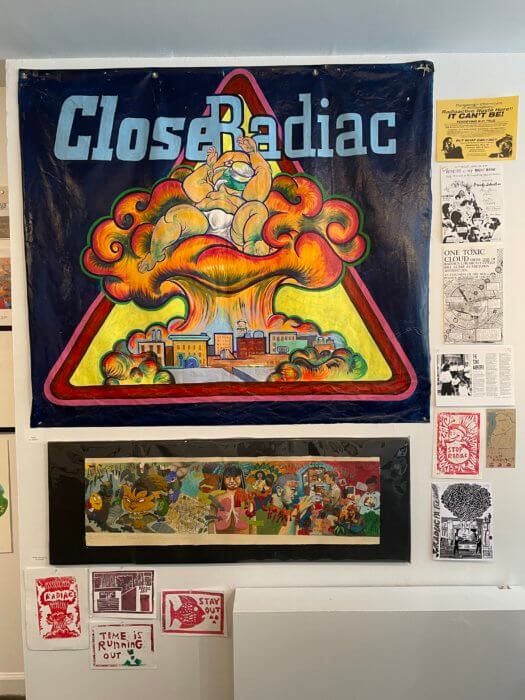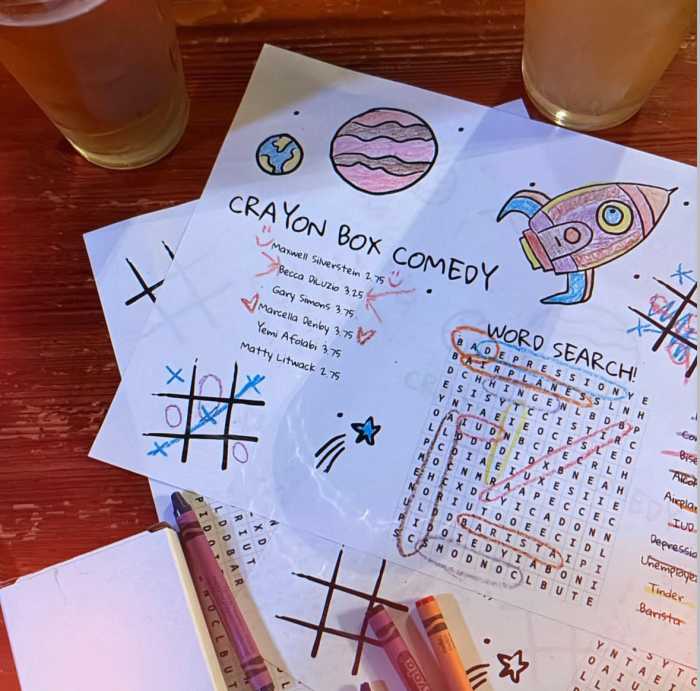For newcomers to New York City, Greenpoint and Williamsburg are some of the most desirable neighborhoods in Brooklyn — and perhaps some of the most sought-after real estate in the entire city. But it wasn’t always that way, and many people don’t know about the long history of environmental activism that has seen the area made clean and safe.
That fight, and the people who spearheaded it, are being commemorated in a new two-part bilingual exhibit titled “Our Voices Seen and Heard: 50 Years of Protest/Nuestras voces vistas y escuchadas: 50 años de protesta,” on display at El Museo de Los Sures and the Greenpoint Library.
Featuring pins, t-shirts, flyers, press clippings, and more, all contributed by members of the community who made and distributed them as they fought to make their communities clean and safe, the exhibit is both a tribute to the past and an encouragement for current environmental activists to keep going.

“Williamsburg and Greenpoint are different communities, but both have been damaged, exploited and fought back,” said Katie Naplatarski, one of the exhibit’s curators, in a press release. “Many newer people to the neighborhood have no idea that what they see around them, every scrap of green and affordable housing is here because residents fought very hard for it. So, this exhibit seeks to bring that fact to life by using artifacts to educate and inspire a newer generation to dream.”
At the center of the exhibition — and of Williamsburg’s environmental activism campaigns as a whole — is Los Sures and El Puente, a pair of South Williamsburg-based nonprofits. The organizations jointly seeking to make the south side of the neighborhood safer and more equitable.
“Veterans” of the climate justice movement gathered at the Greenpoint Library and Environmental Education Center on May 26 for the official opening of the exhibit there — the smaller of two displays, with a larger collection at El Museo de Los Sures.
Amid shelves of pins and flyers urging then-Governor George Pataki to create a waterfront park in North Brooklyn and warning residents about waste transfer stations planned in the neighborhood, Greenpointers took a brief trip back in time as they watched a short documentary about an El Puente-based group called the Toxic Avengers, who fought to close the radioactive waste facility Radiac in 1992.
Longtime activists in the crowd recognized some familiar faces on screen — spouses and El Puente co-founders Luis Acosta and Frances Lucerna — and relived now long-settled battles.
“I’m glad everyone got to see Luis and Frances speak, they are such profound, moving speakers,” said Joe Matunis, a muralist who has worked extensively with El Puente, during a roundtable discussion at the opening.

Matunis moved from Pennsylvania to Williamsburg in 1990, seeking a home for his work as a community muralist.
“As soon as I walked into [El Puente,] and as soon as anyone walks into that space, you feel this amazing spiritual presence, this energy, that Frances and Luis and the entire community brought to that space,” he recalled. “The powerful thing that El Puente did was really empower young people, and the Toxic Avengers was the first environmental group, not the last one.”
Acosta, who was remembered as a “resuscitator” of South Williamsburg, alongside his wife, was passionate about liberation theology and his roots in the Puerto Rican liberation movement, Matunis said, and his passion and work blazed the trail for the environmental activism still at work in North Brooklyn today.
Matunis’ contemporaries — including former Assemblymember Joe Lentol and Los Sures Tenant Organizing Director Barbara Schliff — recalled the most important fights in those early days of the local environmental movement.
Housing cannot be separated from climate justice, noted current Los Sures Executive Director Juan Ramos, at the event, and Schliff remembered tenants in worn-down and neglected Williamsburg apartment buildings coming together to improve their situations and stay in the neighborhoods they call home, with some tenants who worked in the trades using makeshift materials to patch together radiators for the winter season.
“I have been at the struggles of all the important fights,” Lentol said. “We almost won the closing of Radiac, by the way, because [I] put in a bill that went to the governor to close Radiac. We got it passed, with a Republican senate. And the governor vetoed the bill.”

But Lentol saw some massive wins for the community during his tenure, he said, especially when he and the community worked together to stop new waste transfer stations from being built.
Naplatarski invited longtime activists in the audience to share their favorite “wins” of the decades-long climate fight. Some were more recent, like the city’s long-awaited purchase of the CitiStorage lot along the waterfront, which became the final puzzle piece in the yet-to-be-finished Bushwick Inlet Park — the fight for which has been so long it’s commemorated in the exhibit.
Adam Perlmutter, a judge in the city’s criminal court, remembered heading to the Manhattan office of then-governor Elliot Spitzer with Lentol to convince him to put a stop, once and for all, to the proposed TransGas Power Plant. After a contentious meeting, Spitzer finally conceded that New York didn’t need any new power plants on the waterfront, spelling the beginning of the end of the project.
One recent win, a favorite of Newtown Creek Alliance executive director Willis Elkins, calls back to some of those first issues targeted by El Puente, Los Sures, and a community group called Neighbors Against Garbage — waste transfer stations. In 2018, the city council passed a bill seeking to make the burden of handling the city’s trash more equitable. The law was championed by then-councilmember Antonio Reynoso, who became Brooklyn Borough President last year after years of representing Williamsburg in the council.
Last week’s opening was just the beginning, Naplatarski said. The exhibit, which runs through July 31, will include more events, lectures, and roundtables, where the community can keep learning about North Brooklyn’s storied history of activism from the people who have seen it all.
“Our Voices Seen and Heard” runs at the Greenpoint Public Library and El Museo de Los Sures until July 31. For more information about events and hours of operation, check the Our Voices website.

























